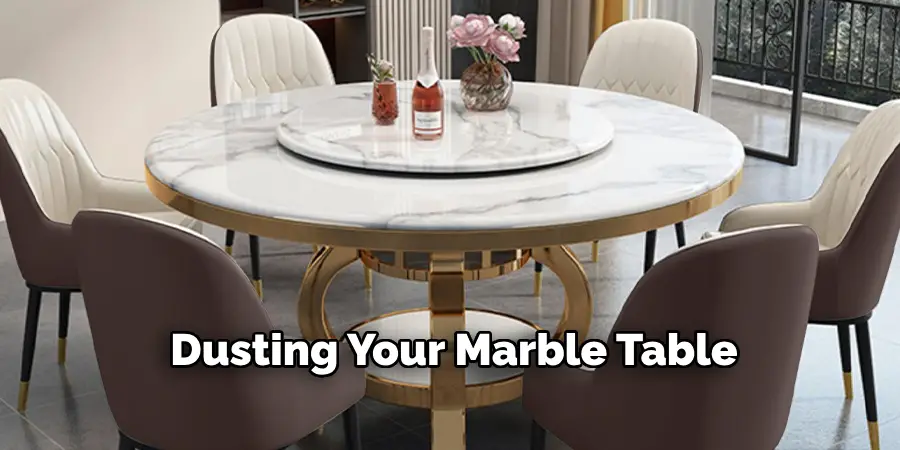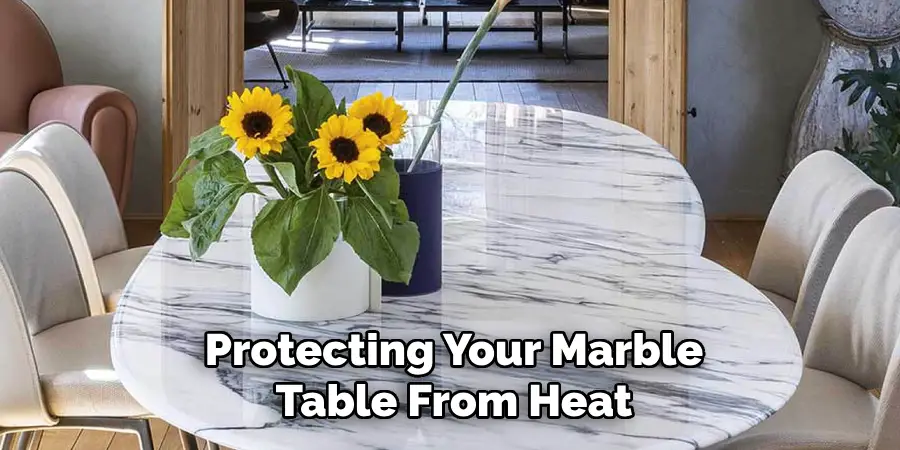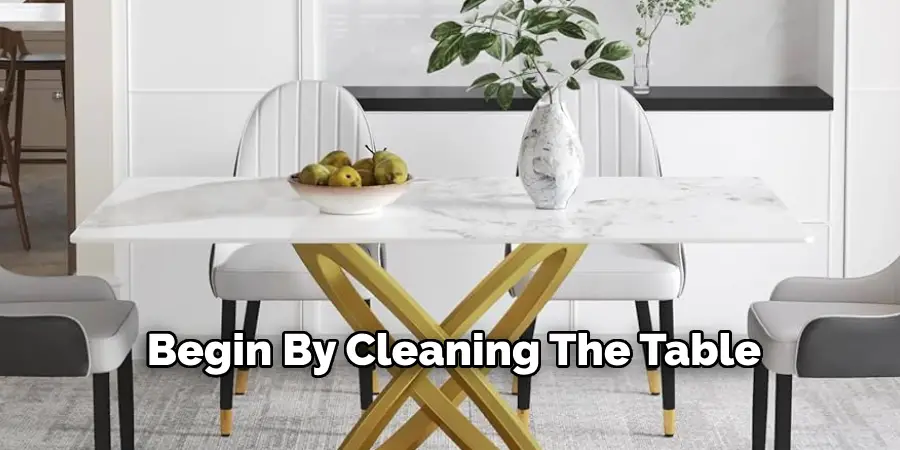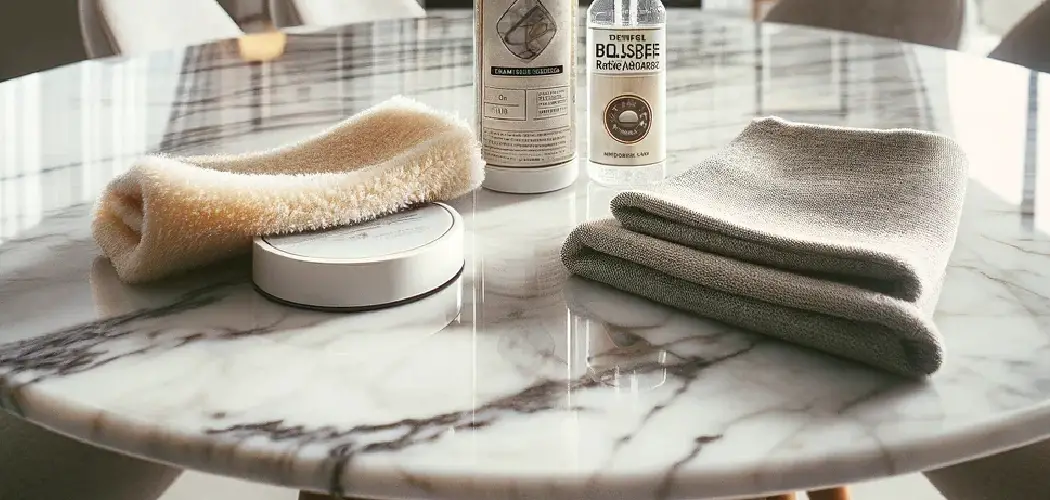Are you looking to treat your marble table and keep it in perfect condition? Marble is a beautiful and durable material, but it requires special care to maintain its natural beauty.
These natural stone surfaces are susceptible to staining, scratching, and etching, especially from acidic substances. To preserve the appearance of your marble table, it is essential to adopt a regular cleaning and maintenance routine. By following appropriate treatment techniques, you can ensure that your marble table remains a stunning focal point while extending its lifespan.

In this guide on how to treat marble table, we will explore the best practices for treating marble tables, covering everything from daily cleaning to preventive measures against common sources of damage. Let’s get started and learn how to maintain the perfect shine on your marble table.
What Will You Need?
Before diving into the treatment methods, let’s look at the necessary tools and materials you will need to treat your marble table properly. These include:
- Soft cloths or microfiber towels
- Neutral pH cleaner or mild soap
- Marble sealer
- Lemon juice, vinegar, or ammonia-based cleaners (for tougher stains)
- Protective mats or coasters
Now that you have all the necessary items let’s delve into the steps for treating your marble table.
10 Easy Steps on How to Treat Marble Table
Step 1: Daily Cleaning
Begin by dusting your marble table with a soft cloth or microfiber towel to remove any loose dirt and debris. It’s essential to use a gentle motion to avoid scratching the surface. For everyday spills or light stains, dampen the cloth with warm water or a solution of neutral pH cleaner or mild soap diluted in water.

Ensure to wring out the cloth thoroughly to avoid soaking the marble, as excessive moisture can seep into the stone and cause damage over time. Wipe the surface gently, following the natural grain of the marble. After cleaning, use a dry cloth to buff the table, thoroughly removing any remaining moisture. Regular daily cleaning keeps the table looking its best and prevents build-up that could lead to more stubborn stains. Remember, avoiding harsh chemicals is key, as they may etch the marble surface, dulling its natural luster over time.
Step 2: Addressing Spills Immediately
One of the most effective ways to prevent stains on your marble table is to address spills immediately. Act quickly by blotting the spill with a soft, absorbent cloth to prevent the liquid from seeping into the marble’s porous surface. Avoid wiping the spill, as this can cause it to spread and make the stain worse. Use a slightly dampened cloth with a neutral pH cleaner to remove any residue if necessary.
Always follow up with a dry cloth to ensure no moisture remains on the table’s surface. This proactive approach not only safeguards your marble from unsightly stains but also helps to maintain its natural beauty over the long term.
Step 3: Preventing Scratches
To keep your marble table in pristine condition, taking preventive measures against scratches is crucial. Marble is a relatively soft stone, making it susceptible to surface abrasions. Always use coasters or placemats when placing glasses, mugs, or objects with rough bases on the table to minimize the risk of scratching.
Additionally, consider using felt pads under decorative items or heavy objects to protect the surface from accidental damage. Regularly inspect the table for any sharp objects or debris that could mar the surface and promptly remove them. By implementing these simple precautions, you’ll ensure that your marble table remains free from unsightly scratches and retains its natural elegance for years.
Step 4: Using a Marble Sealer
Applying a marble sealer is essential in maintaining the integrity and appearance of your marble table. Sealers act as a protective barrier, reducing the table’s porosity and making it more resistant to stains and etching. To start, ensure that the table is clean and dry.

Apply a generous amount of sealer evenly across the surface using a soft cloth or applicator pad, following the manufacturer’s instructions. Let the sealer sit for the recommended time, allowing it to penetrate the marble thoroughly before wiping away any excess with a clean, dry cloth. Typically, resealing should be done once or twice a year, depending on the table’s exposure to spills and frequent use.
Step 5: Tackling Tough Stains
Despite your best efforts, stubborn stains may occasionally occur on your marble table. You’ll need to apply a bit more care to address these tougher stains. Begin by identifying the cause of the stain, as this will guide your cleaning approach. For organic stains like coffee or tea, create a poultice using baking soda and water to form a paste.
Apply the poultice over the stained area, cover it with plastic wrap, and let it sit for 24 hours. Once dry, remove the poultice with a soft cloth and rinse the area with water. For more persistent oil-based stains, consider using a mild dish soap mixed with water, gently scrubbing the area with a soft cloth, and following up with a thorough rinse. Avoid using acidic cleaners like lemon juice, vinegar, or ammonia directly on the marble, as they can damage the surface.
Step 6: Polishing the Marble
Polishing your marble table is a great way to enhance its natural shine and luster. Begin by selecting a marble-specific polish or a non-abrasive commercial stone polish. Before application, ensure the table is clean and dry. Apply a small amount of polish to a soft cloth and gently rub it onto the surface using small, circular motions.
Work in sections to cover the entire table evenly. Allow the polish to sit and dry as per the manufacturer’s instructions, then buff the surface with a clean, dry cloth to reveal a brilliant shine. Regular polishing not only improves the table’s appearance but also provides an additional protective layer against minor scratches and wear. However, remember not to over-polish, as excessive polishing can lead to surface buildup.
Step 7: Avoiding Heat Damage
Protecting your marble table from heat is crucial to maintain its pristine condition. Marble can be sensitive to high temperatures, which can cause discoloration or surface damage. Always use trivets, heat pads, or coasters when placing hot dishes, pots, or cups on the table to prevent heat damage.

Ensuring that your table is shielded from direct heat sources, such as radiators or direct sunlight, can further help to preserve its natural beauty. By integrating these simple protective measures into your routine, you can successfully avoid heat-related issues and prolong the longevity of your elegant marble table.
Step 8: Conducting Routine Maintenance
Routine maintenance is key to preserving the beauty and functionality of your marble table over time. In addition to daily cleaning, allocate time every few months to thoroughly assess the table’s condition. This includes checking for signs of wear, sealing as needed, and ensuring all protective measures, such as coasters and felt pads, are still in place.
Regularly inspect the table’s legs and joints for stability, tightening any loose screws or hardware. A consistent maintenance schedule helps catch potential issues early and ensures that your marble table remains a stately feature in your home for generations.
Step 9: Addressing Cracks and Chips
Despite taking meticulous care, cracks and chips may occasionally appear on your marble table. It’s important to address these imperfections quickly to prevent them from worsening. For minor chips, consider using a marble repair kit, which usually contains a filler material that closely matches the color and texture of your marble.
Clean the area thoroughly before applying the filler, following the kit’s instructions carefully to ensure a seamless repair. For larger cracks or significant damage, consulting a professional specializing in marble restoration might be necessary. Professionals have the expertise and tools required to mend and polish the table, restoring its original elegance.
Step 10: Storing Marble Tables
Proper storage techniques are crucial to preserving its integrity when the need arises to store your marble table, either for home renovations or space considerations. Begin by cleaning the table thoroughly to remove any dust, dirt, or residues. Next, disassemble the table if possible, as this minimizes pressure points and reduces the risk of breakage.
Wrap each component individually in soft moving blankets or bubble wrap to provide cushioning and prevent scratches. Cover the entire piece with a protective sheet or tarp if the table remains assembled. Choose a storage area that is dry, temperate, and away from direct sunlight to prevent moisture damage or discoloration.

By following these steps and incorporating regular maintenance into your routine, you can ensure that your marble table continues to radiate an air of sophistication and beauty for years.
Conclusion
How to treat marble table requires consistent care and proper techniques.
By understanding marble’s unique characteristics and applying regular cleaning, sealing, and protective measures, you can preserve its beauty and functionality for many years. Addressing stains, protecting against heat and impact, and conducting routine maintenance are all integral to caring for a marble table. Should damage occur, timely repair is essential to restoring its original splendor.
With dedication to these practices, your marble table will remain a timeless centerpiece that enhances your living space.
you can also check it out Remove Scratches From Laptop Surface

